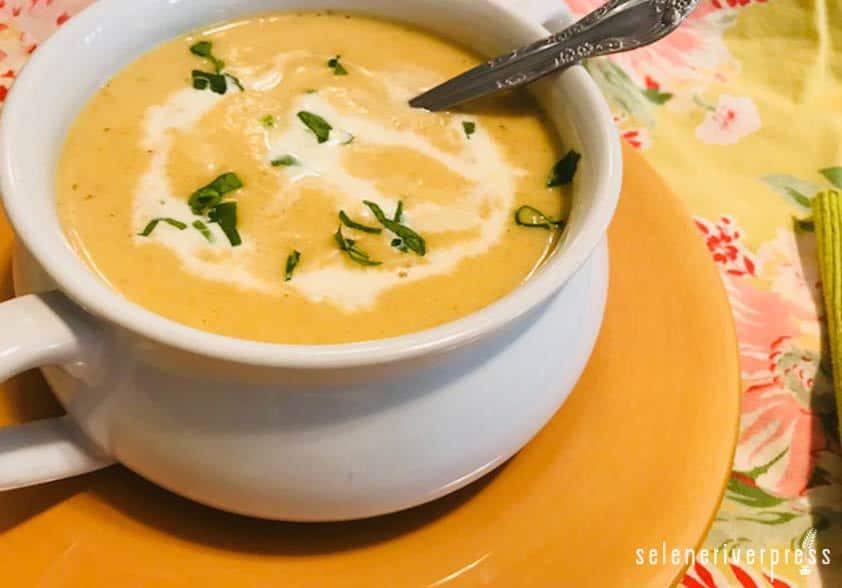Well, here we are, the beginning of March. I can just feel spring around the corner!
Many of you who frequent my blog know that even though I appreciate the downtime of winter, by the start of the year I’m eagerly awaiting the burst of freshness, life, and motion of my all-time favorite season. There are times when the spring in the air is paired with a spring in my step—while wearing flip flops! On those days I must remind myself that weather in Colorado can be quite mercurial, and it’s not unheard of for the brunt of our snow to fall from February to April. In other words, I’m not going to speak too soon.
(My spring bulbs must have been exceptionally grateful that I knew about this tidbit—which only the most seasoned locals seem privy to—when I gave them a fresh, warm, protective blanket of shredded mulch after they decided it was their time to pop from the soil. In January. And not a moment too soon, as the following week we were barely holding temps higher than 15°F, which would have meant bye-bye tulips!)
Knowing we still may have another month or more of chilly weather on our hands, I thought I’d sneak in one more satisfyingly hearty recipe for you all.
Potage d’hiver (pronounced “po-tahj deevair”) literally translates to winter soup, though obviously the French term sounds much more romantic. And I swear it tastes that much better when called by that name. (*Wink*) I was first introduced to this silken blend of nourishing winter produce when I worked at a French café/catering company and instantly fell in love with its simplicity and depth.
This soup requires minimal preparation and makes the most out of the more homely and economical winter produce from the market. We’re ultimately rewarded with a luscious final dish that’s rich in flavor and texture. This humble soup is a staple in many French households, many of them embracing their own particular family recipes.
When I made this soup at the café, we never used a written formula. Instead, we preferred to wing it every time, which I loved, of course. (This kind of spontaneity perfectly illustrated my boss’ previous life in the French countryside, and to me it felt so much more organic and whimsical than my classical French culinary training.)
Even though some freedom was encouraged when we prepared potage d’hiver, our version always had to contain four distinct veggies: leeks, carrots, potatoes, and turnips. This beautiful quartet of roots align perfectly to create a pleasant, warming puree. In my years of winging it, I’ve found my own ideal ratio of veggies is roughly four parts potato, two parts turnips, one and a half parts leek, and one part carrot. The potatoes lend the soup a neutral-yet-buttery flavor and comforting texture. On the nutritional front, potatoes are a good source vitamin C, vitamin B6, potassium, iron, and magnesium. The turnips lend slight undernotes of assertive pungency and delicate sweetness. I believe the mild, oniony essence of the leeks make them the real backbone of flavor in the soup. As for the carrots, too many can make the dish a little sweet for my liking, but in lesser amounts they give it a golden hue and complementary aroma.
I could eat this every day with a smile. But the true beauty of this soup—and just about any other soup, for that matter—is how easy it is to successfully add or substitute other vegetables (fennel bulb and cauliflower work particularly well). You can also vary the ratio to suit your own taste or make the most of the freshest ingredients available to you. Herbs and seasonings are kept to a minimum here. Just enough to accent the veggies and lend some savory notes, but slight enough to allow the vegetables to shine. The incredibly French final touch of swirling in a bit of cream at the end takes it to a velvety level and adds richness. With a side of crusty baguette, and maybe a simple salad, I’m instantly transported to a cozy farmhouse overlooking the rolling hills of the French countryside.
Bon appetit!
Potage d’Hiver
—If you like, leave the potatoes unpeeled to up the nutritional content. However, peeling them will lend the soup a smoother consistency.
Serves 6
Prep time: 10–20 minutes
Cook time: 30–40 minutes
Ingredients
2 lbs. russet or Yukon gold potatoes
1 lb. turnips
½ lb. carrots
¾ lbs. leeks
2 tablespoons butter
1 teaspoon dried thyme
Salt and pepper
Chicken or vegetable stock or broth, or water, to cover
Heavy cream and chopped parsley, to finish
Instructions
- Peel and chop potatoes, turnips, and carrots into similar-sized pieces. Chop leeks (white and light green parts only) and soak them well in cold water for 5–10 minutes, agitating with your hands a couple times to release any grit that may be between the leaves.
- Melt butter in a large pot. Sauté veggies for 5 minutes. Add thyme, salt, and pepper. Cover vegetables completely with stock or water and bring to a boil. Simmer until veggies are tender, about 30 minutes.
- Using a blender, food processor, or immersion blender, puree soup in batches until smooth, transferring each pureed batch to a second pot or bowl as you work. (If using blender, only fill about ⅔ of the way. Hold down lid with a towel while blending, and gradually increase speed. Use caution as hot soup will expand and explode when blended, and this could cause injury.) For additional silkiness, run puree through a food mill after blending.
- Reheat soup on stovetop. Taste and adjust seasoning. Divide among bowls and add a drizzle of heavy cream to each.
Image from Briana Goodall.



